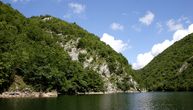One islet on Zlatar Lake never gets submerged: The secret of the "Serbian Atlantis"
In order to build a hydroelectric power plant, several villages were submerged, the remnants of which become visible every time the water level recedes
Halfway from Belgrade to the Adriatic Sea, in the Uvac Valley, lies Zlatar Lake, which is among the ten largest lakes in Serbia.
It was created in the 1960s with the construction of the Kokin Brod hydroelectric power plant.
Entire houses and barns, a school, a police station, a Culture House, and even a church dedicated to St. John the Baptist remained at its bottom. According to the older inhabitants of this area, back in 1961, the roof and the icons from the shrine, erected next to a rock during the migration of Serbs under Arsenije Carnojevic, floated for days on the surface of the new lake.
Because of the decision to submerge everything that had existed in this area for centuries in order to build the power plant, the locals from Uvac villages call Lake Zlatar the "Serbian Atlantis."
But, it often happens that the Zlatar Lake water recedes, which is when submerged villages eerily appear on the cracked ground.
On the other hand, when the water level is high, Zlatar Lake looks like a sea. But, even then, an islet with a cross on it can be seen at its center.
It used a hill, Dumbelsko, on which the Diocese of Milesevo erected a cross in memory of a cemetery which was located at the foot of the hill. The lake never manages to submerge this islet.
Photo: Ivan Strahinic
(Ona.rs)

